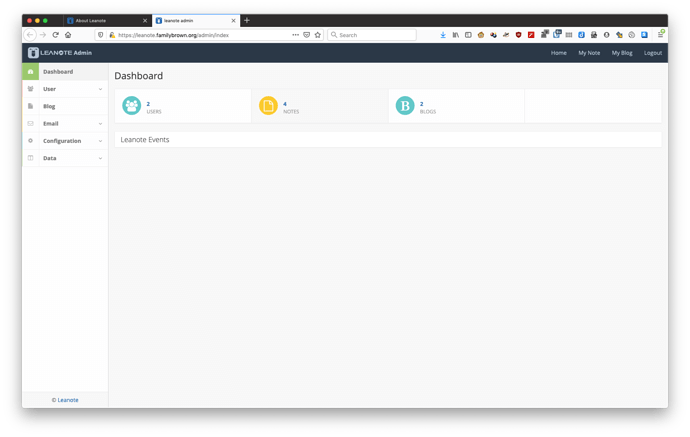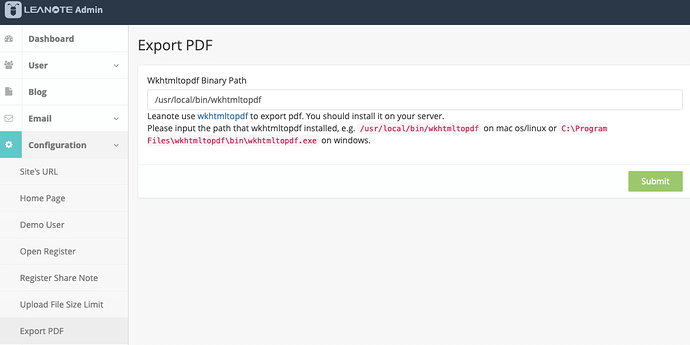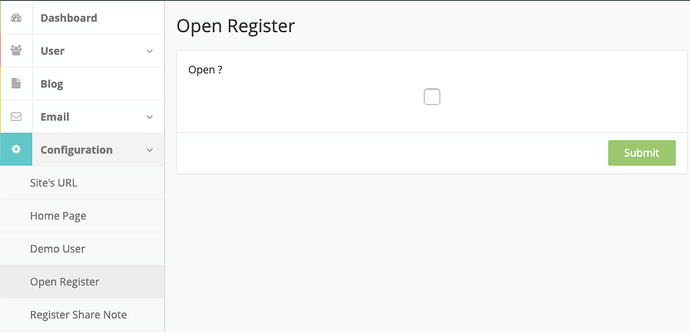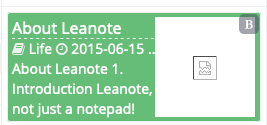OK, @oneitonitram, you asked for it…
Martin requested a “team wiki collaboration” app, and suggested Leanote:
It doesn’t look much like a wiki to me; rather it looks more like note-taking software, and in fact it seems to position itself as a replacement for Evernote. But nonetheless, it seems rather interesting. I don’t promise much effort in updating or maintaining this guide, but since it’s in the Howto category, it’s a wiki post–other users can edit it if desired. This is very basic, but it was enough to get Leanote up and running for me:
Work in Progress
Not for production use
Before you begin
Adjust your TLS certificate to add the hostname of leanote.yourdomain (or whatever hostname you want to assign to your Leanote installation), or create a new certificate for that FQDN. Then run these commands:
yum install mongodb mongodb-server
yum install https://github.com/wkhtmltopdf/wkhtmltopdf/releases/download/0.12.5/wkhtmltox-0.12.5-1.centos7.x86_64.rpm
cd /opt
wget https://sourceforge.net/projects/leanote-bin/files/2.6.1/leanote-linux-amd64-v2.6.1.bin.tar.gz/download
tar xfv download
rm download
systemctl enable --now mongod
mongorestore -h localhost -d leanote --dir leanote/mongodb_backup/leanote_install_data/
mongo
use leanote;
db.addUser("leanote","abc123");
Replace leanote and abc123 in the command above with the desired database username and password. The password should be long and random.
Ctrl-D to exit Mongo.
nano /etc/mongod.conf
On line 70, uncomment auth = true. Save and exit.
systemctl restart mongod
cat /dev/urandom | tr -dc 'a-zA-Z0-9' | fold -w 64 | head -n 1
Copy the output of the command above.
nano leanote/conf/app.conf
- Find the line that has
app.secret=(it should be line 25), delete its current value, and replace with the value you just copied. - On line 8, set
site.urltohttps://leanote.yourdomain(or alternate hostname if desired) - On lines 17 and 18, enter the database username and password you set above.
- Save and exit
nano /usr/lib/systemd/system/leanote.service
Contents are:
[Unit]
Description=Leanote
After=mongod.service
[Service]
Type=simple
ExecStart=/opt/leanote/bin/run.sh
[Install]
WantedBy = default.target
chmod +x leanote/bin/run.sh
systemctl enable --now leanote
Set up reverse proxy
config set leanote configuration
mkdir -p /etc/e-smith/templates-custom/etc/httpd/conf.d/virtualhosts.conf/
nano /etc/e-smith/templates-custom/etc/httpd/conf.d/virtualhosts.conf/15_leanote
You’re creating a template fragment. Its contents should be:
{
my $host = $leanote{hostname} || "leanote";
$OUT .= qq (
# 15_leanote
<VirtualHost *:80>
ServerName $host.$DomainName
RewriteEngine on
RewriteRule ^/\\.well-known/ - [L]
RewriteRule (.*) https://$host.$DomainName\$1 [R,L]
Alias "/.well-known/acme-challenge/" "/var/www/html/.well-known/acme-challenge/"
<Directory "/var/www/html/.well-known/acme-challenge/">
Require all granted
Options -Indexes -FollowSymLinks
AllowOverride None
</Directory>
</VirtualHost>
<VirtualHost *:443>
ServerName $host.$DomainName
SSLEngine on
ProxyPass / http://127.0.0.1:9000/
ProxyPassReverse / http://127.0.0.1:9000/
);
unless ($leanote{AllowDemo} eq 'enabled') {
$OUT .= qq (
RewriteEngine on
RewriteRule ^/demo\$ /login [R=permanent,L]
);
}
if (length $leanote{CertFile}) {
$OUT .= qq (
SSLCertificateFile $leanote{CertFile}
SSLCertificateChainFile $leanote{ChainFile}
SSLCertificateKeyFile $leanote{KeyFile}
);
}
$OUT .= "\n</VirtualHost>\n"
}
Save and exit.
signal-event nethserver-httpd-update
Log in
Browse to https://leanote.yourdomain, and you’ll see a login screen. The default admin user is admin, password is abc123 (which you should change immediately).
Customizing
Leanote will be made available on a virtual host of leanote.yourdomain. If you want to change this (say, to ln.yourdomain), run config setprop leanote hostname ln followed by signal-event nethserver-httpd-update.
By default, the Leanote demo mode is disabled. If you want to allow any visitor to your site to log in as a demo user without a password, run config setprop leanote AllowDemo enabled followed by signal-event nethserver-httpd-update.
By default, the Leanote virtual host will use the system’s default TLS certificate. To use a different cert (perhaps one you’ve obtained just for this virtual host), run:
config setprop leanote CertFile /path/to/cert
config setprop leanote ChainFile /path/to/intermediate/cert(s)
config setprop leanote KeyFile /path/to/private/key
signal-event nethserver-httpd-update
Important Admin settings
There are a few settings you’ll need to change, and others you’ll want to be aware of. Log in as the admin user, and in the upper-right corner of the screen, click on that user’s menu and select Admin:
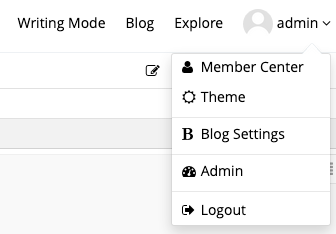
This will take you to the administration page:
Save as PDF
To save notes as PDF, Leanote needs to know where the wkhtmltopdf binary is. To set that, on the left, click on Configuration, then on Export PDF. Enter the path to wkhtmltopdf, which is /usr/local/bin/wkhtmltopdf. Then click Submit:
Database backup/restore
On the left, click on Data, then Mongodb Tool Configuration. Enter the correct paths as shown here. Both mongodump and mongorestore live in /usr/local/bin/. Then click Submit.
Disable registration
Leanote does not synchronize its users with your Neth system, and by default, anyone who can reach your Leanote installation can register an account there without even needing to verify their email address. Unless your installation is on a protected network, you probably don’t want this. To disable registration, on the left, click on Configuration, then on Open Register. Uncheck the box and click Submit.
To Do
- Security
- MongoDB authentication
- Disable account registration
- Access control–allow access only from specified networks
- Delete demo user/Try It button
- Reverse proxy setup
- Both for virtual host and subdirectory
- systemd unit to start Leanote on boot (and in background)
- LDAP/AD authentication?
wkhtmltopdf: cannot connect to X server- Figure out if there’s a Leanote fork that’s better maintained–Leanote itself hasn’t had a commit in over a year, or a release in over two years, and there are nearly 500 open issues.
- RPM for Leanote itself
- Nethserver module to integrate
